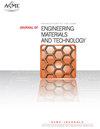Physically-based Constitutive Modeling of Dynamic Strain Aging in C45 Steel
IF 1.9
4区 材料科学
Q3 ENGINEERING, MECHANICAL
Journal of Engineering Materials and Technology-transactions of The Asme
Pub Date : 2023-08-04
DOI:10.1115/1.4063118
引用次数: 0
Abstract
Dynamic Strain Aging (DSA) is a sudden increase in the strength of a material under certain combinations of temperatures and strain rates. Despite the phenomenon being reported in several other studies, the literature still lacks a specific constitutive model that can physically interpret its effect. Therefore, this work proposes a modification based on physical parameters to the Voyiadjis and Abed (VA) model to account for the effect of DSA in C45 steel. The resulting modified model is then coupled with an energy-based damage model to further capture the effect of material softening. Previously, in VA model, it was assumed that the total activation energy for overcoming the obstacles without external work remains same which works well in the absence of DSA. However, during DSA, the mobile dislocations are pinned by the diffusing solute atoms. This results in an increase in the total activation free energy needed by the dislocations to overcome the obstacle. Thus, an increase in strength is observed. It is shown in the current work that utilizing the concept of increased solute concentrations at local obstacles, in conjunction with the physical description that the VA model is based upon, successfully captures the phenomenon of DSA in C45 steel. In addition, the metal experiencing softening after reaching its ultimate strength is due to the significant growth of voids and cracks within the microstructure. To capture this behavior, an energy-based damage parameter is incorporated into the proposed model. The coupled plasticity-damage model shows a good comparison with the experimental results.C45钢动态应变时效的物理本构建模
动态应变老化(DSA)是材料在一定温度和应变率组合下强度的突然增加。尽管在其他几项研究中也报道了这一现象,但文献中仍然缺乏一个具体的本构模型,可以从物理上解释其影响。因此,本工作提出了基于物理参数的Voyiadjis和Abed (VA)模型的修改,以考虑DSA对C45钢的影响。然后将得到的修正模型与基于能量的损伤模型相结合,以进一步捕获材料软化的影响。以前,在VA模型中,假设在没有外部功的情况下,克服障碍的总活化能不变,在没有DSA的情况下效果很好。然而,在DSA过程中,移动位错被扩散的溶质原子所固定。这导致位错克服障碍所需的总激活自由能增加。因此,可以观察到强度的增加。目前的研究表明,利用局部障碍处溶质浓度增加的概念,结合VA模型所基于的物理描述,成功地捕获了C45钢中的DSA现象。此外,金属在达到极限强度后出现软化是由于微观结构中空洞和裂纹的显著增长。为了捕捉这种行为,在模型中加入了基于能量的损伤参数。所建立的塑性-损伤耦合模型与试验结果吻合较好。
本文章由计算机程序翻译,如有差异,请以英文原文为准。
求助全文
约1分钟内获得全文
求助全文
来源期刊
CiteScore
3.00
自引率
0.00%
发文量
30
审稿时长
4.5 months
期刊介绍:
Multiscale characterization, modeling, and experiments; High-temperature creep, fatigue, and fracture; Elastic-plastic behavior; Environmental effects on material response, constitutive relations, materials processing, and microstructure mechanical property relationships

 求助内容:
求助内容: 应助结果提醒方式:
应助结果提醒方式:


